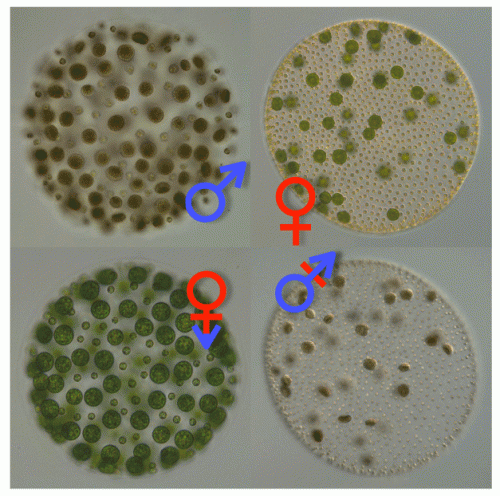Transgender algae reveal evolutionary origin of sexes

Throughout evolution, living things have repeatedly developed physically distinct sexes, but how does this actually happen? A discovery in the multicellular green alga, Volvox carteri, has revealed the genetic origin of male and female sexes, showing how they evolved from a more primitive mating system in a single-celled relative.
A team of scientists led by James Umen, Ph.D., Associate Member, Enterprise Institute for Renewable Fuels at the Danforth Plant Science Center, identified the master regulatory gene for sex determination in Volvox and found that it has acquired new functions compared to a related gene in its close relative, the unicellular alga Chlamydomonas reinhardtii, which does not have physically distinguishable (dimorphic) sexes. Their findings are publishing in the open access journal PLOS Biology on July 8, and may also provide a possible blueprint for how sexes in other multicellular organisms like plants and animals may have originated.
For plants and animals having male and female reproductive cells or gametes is the norm, and the differences between the two types of gametes are obvious. Male gametes are small motile sperm or pollen, while female gametes are large egg cells. However, the evolutionary origins of male and female sexes are unclear because the distant unicellular relatives of plants, animals and other multicellular species generally don't have distinct sexes, but instead have mating types - a system in which gametes of one mating type can only fuse with those with a different mating type, but the cells of each mating type are indistinguishable from each other in size and morphology.
Unlike the case in plants and animals whose unicellular ancestors are very distantly related, male and female sexes in Volvox evolved relatively recently from mating types in an ancestor that was similar to Chlamydomonas. During a previous study, Umen and co-workers – postdoctoral fellows Sa Geng and Peter DeHoff – had identified a gene in Volvox males called MID whose counterpart in Chlamydomonas was known to control differentiation of its two mating types called "plus" and "minus".
By forcing genetically female Volvox to express MID, the team led by Umen was able to convert what would have been egg cells into packets of functional sperm cells. Conversely, by using a method of gene inactivation called RNA interference (RNAi), the Danforth scientists were able to block MID expression in genetic males causing them to develop with functional eggs in place of their sperm packets. The team was even able to use their gender-swapped strains to carry out successful matings between pairs of genetically male or genetically female Volvox. Importantly, even though the MID genes from the two species of algae are related, the Chlamydomonas MID gene was unable to substitute for Volvox MID. The discovery of a master regulatory gene for sexes and mating types in this group of green algae shows that these two forms of reproduction share a common genetic origin, and hint that a similar evolutionary scenario may underlie the origin of sexes in animals, plants and other multicellular lineages.
In addition to the evolutionary insights gained by Umen's research team, there are also practical implications for algal biotechnology. "Just as is the case for crop plants, breeding will be an important tool for making improved algal strains that can serve as biofuel feed stocks or other purposes. However, sexual reproduction in most algal species is poorly understood. The identification of a conserved regulatory gene that controls sex and mating in the algae may lead to clues about how sex is controlled in other related groups of algae that are used for biotechnological applications," Umen said.
More information: PLOS Biology, www.plosbiology.org/article/in … journal.pbio.1001904
Journal information: PLoS Biology
Provided by Public Library of Science




















